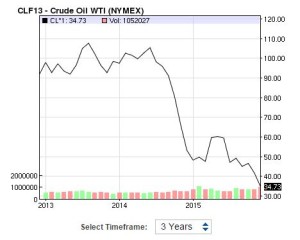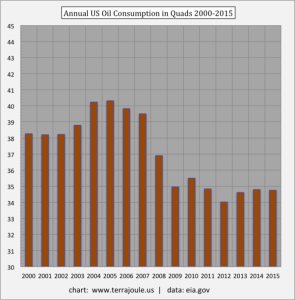
See that graph there? That’s the price of oil for the period 2013 through 2015.
Here’s the question: Why has oil fallen in price so dramatically?
I know what the standard answer is — The US has had the shale oil boom, and become nearly self-sufficient, and that increase in supply has led to the fall.
But there’s a problem with that. Saudi Arabia.
I was listening to the BBC’s World Service earlier today, and they had an interview with someone giving a bracing analysis of the conditions in Saudi. Austerity as far as the eye can see, with major projects being cancelled, all because their population is rising, even as their oil revenues have dropped off.
I had to ask: Why?
It’s been a given for decades that the Saudis are the swing producer in global oil production. The price of oil largely depends on how much oil Saudi Arabia brings to market.
So why haven’t they reduced their output? Why haven’t they taken steps to offset whatever increases the US may be bringing to the market, so the price can be stable? Why are they risking their own internal stability by allowing oil supply to be so high it depresses prices?
The only thing I can guess is… The Saudis are scared to death of a dropoff of demand. Which would cause oil prices to slump even lower.
This has always been my problem with the Peak Oil hypothesis. If we really are so close to the peak, and thus a dramatic increase of price, every barrel of oil sold today forgoes that future higher price. So, why sell oil on what is essentially a discount? Why were the Saudis selling like there was no tomorrow?
Again — the only thing I can think of (and I would welcome a different idea) is the Saudis are frightened demand is a will of the wisp, and subject to collapse.
How much oil do the Saudis have? What do they think of their prospects to sell that oil in the future? Look at what the Saudis do, not what others say.

